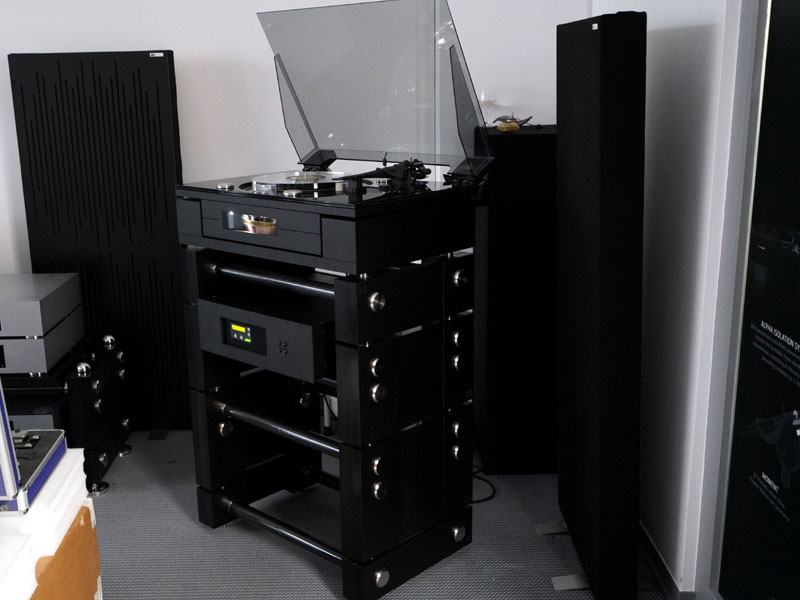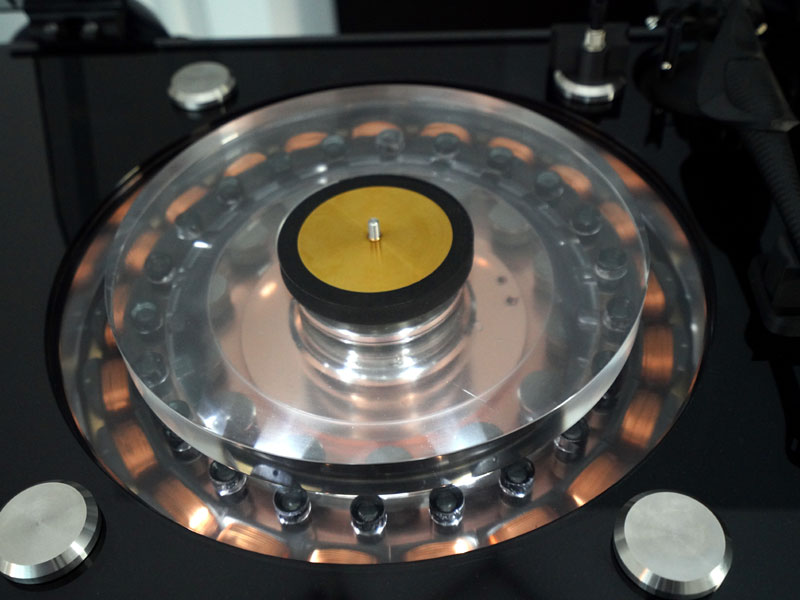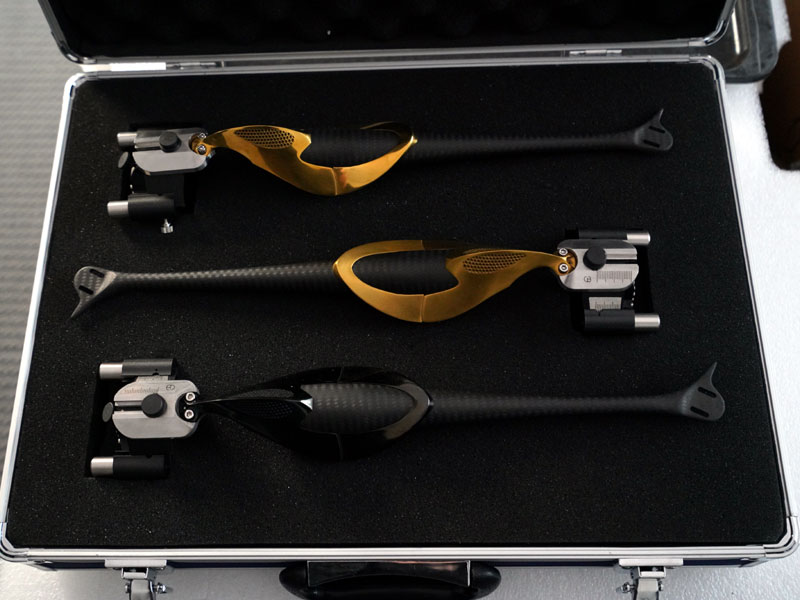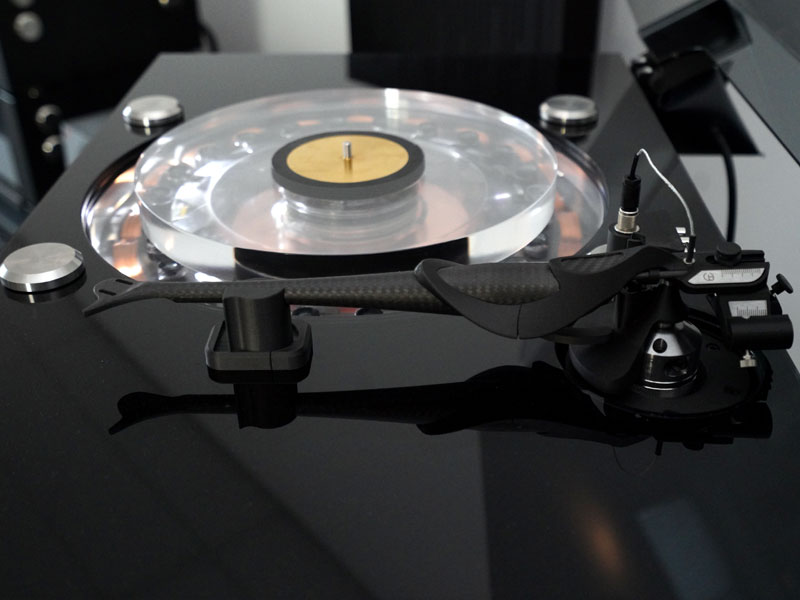High End 2019 • TABlog
ounger members of the audio community who are familiar with Wilson Benesch loudspeakers might well be unaware that the company started life building turntables -- turntables that employed then-innovative materials like carbon-fiber composites. Since then, turntables and tonearms have been an ever-present, if lower-key, part of the product range, but analog replay remains close to designer Craig Milnes' heart. Therefore, perhaps it is only fitting that as the they mark their 30th anniversary, Wilson Benesch is back in the cutting-edge record-replay market -- and how.
Meet the GMT One, a record player with more parts, more engineering and more technological innovation than it’s possible to cover in a relatively concise report like this. At the core of the turntable is a brand-new drive system, the Omega drive, developed for defense applications. An axial magnetic drive system, it offers silent operation, incredible efficiency, high power and very low friction. Crucially for audio applications, it is also extremely speed stable and accurate. I’d be lying if I said I understood how it works, but in essence, a high-speed rotor roughly eight inches in diameter is used to induce drive into an outer stator that spins at 33rpm. The combination of high speed and step down creates the equivalent of an electronic flywheel effect, producing massive inertia (and hence speed stability) from a relatively low mass. An axial system running off of a single phosphor-bronze standing bearing, the drive creates force that is concentric to avoid sideways movement or resonance, while the drive rotor is magnetically floated, the whole system promising an incredibly low noise floor. The Omega drive is patented and licensed, meaning that Wilson Benesch is the only audio company getting to use it -- so you won’t find another outside of a nuclear submarine.
An all-new drive system would be remarkable enough, but with the GMT One, that’s only the beginning. The platter and drive are mounted into an aluminum, carbon-fiber and laminated glass plinth, which is in turn floated on a self-leveling air suspension. You might well wonder why, given the air suspension, the deck doesn’t employ an air bearing too, but Wilson Benesch is adamant that the mechanical discontinuity introduced by using air bearings robs the sound of dynamic range and authority, as well as the bearing medium being a source of noise and geometrical variation -- all highly undesirable. The plinth and suspension are in turn integrated into a Wilson Benesch R1 rack, which houses the control electronics and phono stage (we’ll get to that later) as well as dedicated storage for three platters, two tonearms and the setup tools. Three platters? The GMT One is supplied with three different main platters, one in Acrylic, one in Delrin and a third that will be additive manufactured, although the precise material composition is yet to be fixed. Each platter offers a different sonic perspective or sound, allowing owners to tune the sound of the ‘table, or even switch platters to suit different recordings or labels.
The massive plinth will accommodate two tonearms, a second can be mounted across the rear of the platter, but it comes as standard with the matching Wilson Benesch tonearm(s) included in the package. There are three new 'arms: the low-mass Moment, the medium-mass CTi-30 and the high-mass Graviton, the interchangeable armtops all compatible with the plinth-mounted bearing system, allowing owners to exchange armtops quickly, in an arrangement very reminiscent of VPI’s JMW tonearms. This makes even more sense when you realize that the height of the bearing is remotely controllable, giving owners remote VTA adjustment in 2.5-micron steps -- about half the width of a red blood cell. Each armtop is a composite construction featuring a carbon nanotube armwand (a carbon/foam sandwich construction is used in the Graviton) mated to a two-part bridge that clamps the wand, houses the three-ball bearing interface and supports the counterweights, additive-manufactured cages that house interchangeable 4mm rods to adjust total mass. The weights can be precision-adjusted to set azimuth and VTF, settings they retain, even when swapped off of the deck. Effective mass is altered by mixing the materials in the two-part, 3D-printed bridge element. The Moment uses an all-carbon construction, the Graviton all-titanium and the CTi-30, half and half. With one 'arm on the deck, the other two can be stored in the rack, while the setup jig allows you to align cartridges with the armtops dismounted. Finally, there will also be a matching cartridge and dedicated phono stage, with the cartridge’s mechanical characteristics matched precisely to one of the tonearm tops -- although for the moment the operating principle and details of the cartridge are not being released. Of course, that leaves two armtops (or more) for other cartridges -- and that’s before you get to the second 'arm that owners might mount.
The GMT One is named for Greenwich Mean Time, the universal time constant to which the whole world relates. It’s an ambitious association, but one that, given the technology, materials and engineering involved, suddenly doesn’t seem all that fanciful. This is a turntable that really does bring new meaning to the term record-replay system, with the turntable, rack, tonearms, cartridge, tools and storage all included in the price. Ah, the price. That is yet to be fixed, but potential
owners should expect to be paying top-of-the-art-type money for the GMT One, while waiting
until Q1 of 2020 for delivery. This is one record player that really could rewrite the
rules of record replay and for those who demand the best and can afford it, I suspect that
neither the price nor the wait will be prohibitive. Indeed, given the completeness of the
package and the cost of the competition, it could well constitute something of a bargain.
Those of us who might struggle to raise upwards of 300,000 (in just about any currency you
might define) will have to console ourselves that this technology will inevitably filter
down -- eventually. |




